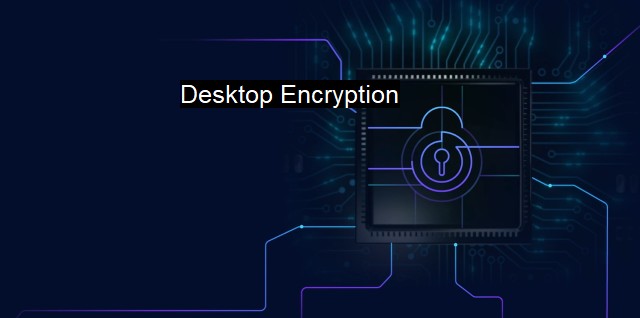What is Desktop Encryption?
Enhancing Cybersecurity in Today's Digital Age through Desktop Encryption: Safeguarding Personal and Sensitive Data
Desktop Encryption is a critical area within the broader cybersecurity and antivirus field. It refers to the process of converting electronic data into a different form - one that an unauthorized user cannot easily understand or interpret. The main goal of this technique is to secure confidential data when it's stored, in transit or when it's being used on a computer, thus preventing unauthorized users from accessing or altering it in any way. In other words, desktop encryption ensures that only individuals with the exact decryption key or correct password can read or edit the information.With desktop encryption aids in protection against cyber threats, data breaches, theft, or corruption of sensitive information. Often this information includes personal and financial details that, if made accessible, could result in identity theft, leading to significant financial losses or even damage to one's reputation.
There are two primary types of desktop encryption; disk encryption and file encryption. Disk encryption involves the encryption of an entire hard drive so that not just individual files and folders, but the entire contents of the computer are secured. This is most effective against physical security threats, such as if the computer is stolen or misplaced. File encryption, on the other hand, involves encrypting specific files or folders. This grants an additional security layer where you can selectively protect sensitive information.
One key aspect of encryption is the encryption algorithms used. These are essentially the mathematical instructions that control how the encryption and decryption processes are executed. These algorithms take a 'key' (a randomly generated string of bits) and the data to be encrypted, then transform the data into an unreadable format. Some of the commonly used encryption algorithms include Advanced Encryption Standard (AES), Rivest-Shamir-Adleman (RSA), and Two fish among others.
The more one dives into the subject of desktop encryption, the clearer it becomes that it is a daunting but unavoidable task due to its instrumental role in preserving the integrity of stored, transferred, and used information. Still, it's crucial to remember that encryption should always be considered as just one parameter within a complete cybersecurity strategy. It's not a perfect fix-all, and the level of protection it offers can vary based on its implementation. Other aspects such as firewalls, antiviruses, regular updates, secure networks should also be used in conjunction with it.
Also, since encryption systems rely on a series of complex mathematical equations to work effectively, if there are any shortcomings in the software or the algorithm used, it can potentially result in a security vulnerability. Thus, it is crucial to apply patches and keep both operating systems and encryption software up to date to offer the highest level of desktop encryption.
Human error can also lead to encryption failures. For instance, users may forget their encryption key or password, or they may unknowingly give confidential information to people who might misuse it. Hence, continuous education and deliberation about cybersecurity best practices can mitigate these risks and enhance security.
Advancements in technology are quickly pushing us towards a future where desktop encryption and other similar security measures are no longer optional but mandatory. As increasingly sophisticated cyber threats emerge, organizations and individuals need to ramp their cybersecurity efforts and pay close attention to the protection of their electronic assets.
Putting it all together, in the ecosystem of cybersecurity, desktop encryption is a significant tool at disposals to protect sensitive and personal information from prying eyes. Though not without flaws, its use can help bridge the gap between potential security risks and the discontentment towards cyber-vulnerabilities. When implemented with care, alertness, and sophistication, desktop encryption can parlay an important role in bolstering the shields in a robust cybersecurity framework.

Desktop Encryption FAQs
What is desktop encryption?
Desktop encryption is a security measure that involves encrypting the data stored on a desktop computer. This process ensures that the data cannot be accessed by unauthorized users even if they gain access to the computer.Why is desktop encryption important for cybersecurity?
Desktop encryption is important for cybersecurity because it protects sensitive information from being accessed by cybercriminals who may attempt to steal or use the information for malicious purposes. With desktop encryption, even if hackers gain access to a computer, they will not be able to read the encrypted data.What are the different types of desktop encryption?
There are two main types of desktop encryption: full disk encryption and file-level encryption. Full disk encryption encrypts the entire hard drive of a computer, while file-level encryption encrypts individual files and folders.Do I still need antivirus if I have desktop encryption?
Yes, antivirus software is still necessary even if you have desktop encryption. While encryption protects your data from being accessed by unauthorized users, antivirus software helps protect your computer from malware and viruses that can compromise the security of your desktop system.| | A | | | B | | | C | | | D | | | E | | | F | | | G | | | H | | | I | | | J | | | K | | | L | | | M | |
| | N | | | O | | | P | | | Q | | | R | | | S | | | T | | | U | | | V | | | W | | | X | | | Y | | | Z | |
| | 1 | | | 2 | | | 3 | | | 4 | | | 7 | | | 8 | | |||||||